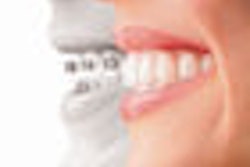In-office bleaching may adversely affect the surface texture of composites, according to a new study (European Journal of Dentistry, April 2010, Vol. 4:2, pp. 118-127).
Researchers from the Cairo University Department of Operative Dentistry wanted to determine color changes and surface roughness of composites when they were subjected to in-office bleaching.
They prepared 12 disks from two shades (A2 and A4) of two composites: Heraeus Kulzer's Durafill VS (DF) and Dentsply Caulk's TPH3 (TPH). Each group of specimens (DF-A2, DF-A4, TPH-A2, and TPH-A4) were subdivided into three subgroups and bleached with Beyond (Beyond Dental and Health), LumaWhite-Plus (LumaLite), and Opalescence-Boost (Ultradent Products).
The disks were bleached, stained, and then rebleached.
The researchers took colorimetric measurements at baseline and after bleaching, staining, and rebleaching.
Among their findings:
- None of the bleaching systems notably changed the color of composites.
- Coffee staining affected DF specimens more than TPH.
- Stained specimens showed variable responses to whitening with no significant color change observed with TPH and significant changes observed with DF.
- Surface roughness significantly changed with bleaching, but the degree varied according to composite shade and bleaching agent.
"Dentists should take into consideration that composite restorations may not respond to bleaching in the same way that natural teeth do," the authors concluded.
Copyright © 2010 DrBicuspid.com



















